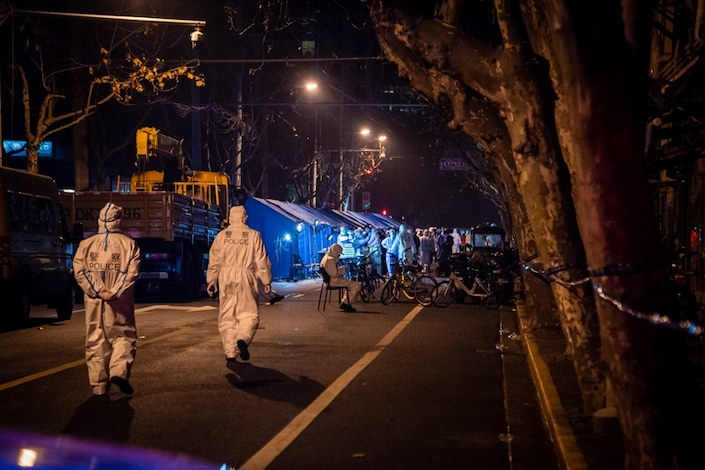Cover Story: Threat of Renewed Pandemic Freezes China’s Annual Travel Rush

For Ma Changjiang, Wang Juan and many of 300 million other migrant workers in China, there will be no once-a-year trip home to celebrate the 2021 Lunar New Year thanks to restrictions to limit a resurgence of the Covid-19 pandemic.
Ma, a plasterer working in southern China’s Guangdong province, scrubbed his 1,000-mile trip home to northern China’s Hebei province as this year’s holiday begins Feb. 12. He cited the rigorous quarantine and testing restrictions imposed by his village, which is about 1 kilometer from Nangong, one of the cities in Hebei with the highest level of risk in a recent outbreak.
“It is very sad that I can’t make my trip home as it is the only chance in a year,” Ma said. “But there is nothing (I) can do.”
Domestic worker Wang similarly won’t be going home from Beijing to visit her husband and children in Jiaozuo, Henan. Under local policy, travelers from Beijing need to quarantine for 21 days in designated hotels at their own cost.
“The holiday will be over after 21 days of quarantine,” Wang said. “What is the point for me to go back?”
This year’s holiday travel boom will be even smaller than last year’s as governments across the country ramp up virus control measures ahead of traditionally each year’s busiest travel. The Ministry of Transport estimated last week that there will be about 1.15 billion trips during this year’s holiday season, the fewest on record since the government began releasing the data in 2003.
A year ago as the pandemic emerged, Lunar New Year travel fell by half from the 3 billion journeys recorded in 2019. This year’s estimate is 20% lower than last year’s total, and the transport authority said the actual number of trips could be even fewer. Already, the number of trips taken by road, rail, airplane and boat are down about 50% from the comparable period last year, according to the transport authority.
A year after the pandemic began, China now faces the challenge of preventing the virus from spreading more deeply into its vast rural areas, especially during the Lunar New Year holiday when hundreds of millions of people normally travel from big cities to their rural hometowns. Such fears sparked local authorities to resort to strict measures to stop returnees, spurring public criticism that some of them may be excessive
Rampant spread of the virus globally means that the pandemic’s threat to China will persist until large-scale vaccinations worldwide effectively contain the virus’s spread, experts said. Before that, the country needs to develop more sophisticated and targeted virus responses that could prevent chaos and unnecessary costs. Different strategies should be designed to fit the needs of different regions, they said.
Globally, the novel coronavirus has sickened more than 100 million people and killed 2.2 million, according to Johns Hopkins University.
Read more
Caixin’s coverage of the new coronavirus
The State Council, China’s cabinet issued an unusual call to the public Jan. 25 for people to stay put and avoid nonessential trips during the Lunar New Year period. The government’s message reflects mounting concerns that the annual Spring Festival travel rush, known as Chunyun (春运), will brew increased risks for the spread of the coronavirus.
As winter fell, China encountered its worst resurgence in nearly 10 months as new clusters were reported in several provinces. Between Jan. 2 and 28, more than 2,600 new cases were confirmed in north China’s Hebei and northeast China’s Heilongjiang and Jilin provinces. In response to the surge of new infections, several cities reimposed lockdowns and conducted mass virus testing of millions.
Rural loopholes
In addition to its Jan. 25 notice calling on Chinese to “celebrate in place,” the State Council also said interprovincial travelers will have to present a negative Covid-19 test result from the preceding seven days, starting Jan. 28. The cabinet urged people to practice 14 days of home quarantine after arriving and not to attend large gatherings.
Some areas’ requirements are even stricter, requiring a negative result from the prior three days for those traveling from higher-risk areas. Although Beijing has ordered local authorities not to add excessive requirements and block necessary travel, many localities have scrambled to ramp up control, reflecting fears of infection risks from massive visitor flows during the holidays.
“Recent outbreaks in Hebei and the northeast sounded the alarm for us,” said a county official in Henan, one of the largest sources of migrant workers from its vast rural regions.
The latest waves of resurgence in northern China spotlighted the fragility of rural areas in the face of the virus, the official said.
The official’s county found in a survey that 40,000 people planned to return during this year’s holidays, compared with about 100,000 last year, she said. The county is home to 200,000 migrant workers, according to the official.
Recent outbreaks in Hebei and Heilongjiang started in rural areas and spread quickly. Contact tracing later found that the wide spread was partly due to late discovery of earliest cases.
Compared with urban areas that have been fully equipped and on high alert for the pandemic, many rural areas haven't encountered large outbreaks and were unprepared, said Wang Chenguang, a professor at Tsinghua University in Beijing.
On Jan. 20, the State Council issued a notice ordering local authorities to view epidemic prevention and management in rural areas as “a matter of the utmost importance” and keep track of people returning to hometowns ahead of the holidays.
“Disease control capacity in rural areas is weak, and controlling the epidemic is difficult, especially as the number of people returning home during the Lunar New Year rush markedly increases … and further increases the risk of transmission,” the National Health Commission (NHC) wrote in an article outlining virus control measures for rural returnees.
The biggest challenge in rural disease control is to enhance the capacity of local health institutions so that they can detect the virus quickly, said Lu Hongzhou, head of the Shanghai Public Health Clinical Center.
Big cities remain the focus of virus control, but policy documents indicated that more attention is being paid to rural areas, said Jiang Qingwu, a public health expert at Fudan University in Shanghai.
Balancing act
Following months of nationwide lockdown measures, China largely put domestic outbreaks under control since April and gradually reopened to normal activity levels. Since then, authorities have sought to set up more normalized approaches for virus control to reduce the impacts on social and economic activities.
Big cities including Shanghai and Beijing have developed more-targeted strategies involving limited restrictive measures and rapid virus screening to successfully contain sporadic outbreaks.
 |
In response to the surge of new infections, several cities reimposed lockdowns and conducted mass virus testing of millions. |
However, in the face of the recent resurgence sweeping North China and pressure from the holiday travel rush, some local authorities again turned to drastic measures. For instance, in Tonghua, Jilin province, an abrupt lockdown and lack of preparation left many residents without enough food and necessities when they were forced to stay home, exposing an emergency response failure.
Meanwhile, rounds of virus tests involving millions were ordered in many places, raising questions whether the mass testing was necessary. In Shijiazhuang, Hebei province, three rounds of nucleic acid tests were conducted on all 10 million residents over the past few weeks, while people in some districts with high risk were tested as many as five times.
Beijing also tested millions of people after several cases were reported in its southern district of Daxing.
Under the latest holiday travel rules issued by the NHC, a migrant worker who wants to return to rural Henan from Shanghai would need to take at least four nucleic acid tests during a round trip, according to Soochow Securities Co.
Some experts said that although rapid virus testing is crucial for tracing infections, it should be conducted in consideration of costs, and the current expansive use could be excessive. In many cities, recent tests covering millions of people often detected only a few infections.
“I feel the current screening is excessive,” said a public health expert in Beijing. “We’ve done tests for millions in many places and found nothing at the end. … It is unnecessary to do it in some places as community spread has been effectively controlled.”
Aggressive measures by local authorities reflect concerns over capacity to control the virus, especially in rural areas, analysts said. Officials are also under pressure because they would be held accountable for any failure to contain an outbreak. Dozens of officials have been punished in Hebei and Heilongjiang for the recent resurgences.
Read more
Cover Story: The Daunting Challenge of Immunizing the World
Compared with most countries’ strategies for slowing the virus’s spread, China has stuck to a much more aggressive goal of eliminating domestic cases. Under this principle, localities across China will remain on high alert to eliminate new outbreaks probably until next year, one local official said.
But Shanghai’s Lu is more optimistic. As the weather gets warmer and inoculations expand globally, the pandemic will gradually come under control worldwide and people will “be able to travel home for the next Spring Festival,” he said.
Contact reporter Han Wei (weihan@caixin.com) and editor Bob Simison (bobsimison@caixin.com).
Download our app to receive breaking news alerts and read the news on the go.

- MOST POPULAR





